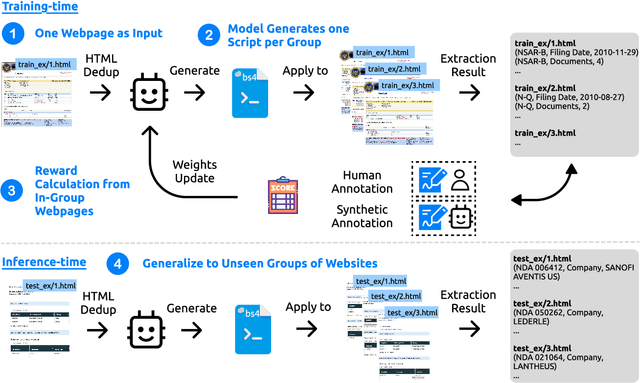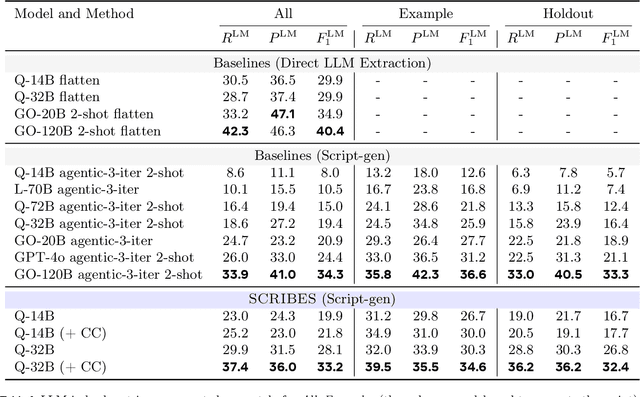Information Extraction
Information extraction is the process of automatically extracting structured information from unstructured text data.
Papers and Code
HTMformer: Hybrid Time and Multivariate Transformer for Time Series Forecasting
Oct 08, 2025Transformer-based methods have achieved impressive results in time series forecasting. However, existing Transformers still exhibit limitations in sequence modeling as they tend to overemphasize temporal dependencies. This incurs additional computational overhead without yielding corresponding performance gains. We find that the performance of Transformers is highly dependent on the embedding method used to learn effective representations. To address this issue, we extract multivariate features to augment the effective information captured in the embedding layer, yielding multidimensional embeddings that convey richer and more meaningful sequence representations. These representations enable Transformer-based forecasters to better understand the series. Specifically, we introduce Hybrid Temporal and Multivariate Embeddings (HTME). The HTME extractor integrates a lightweight temporal feature extraction module with a carefully designed multivariate feature extraction module to provide complementary features, thereby achieving a balance between model complexity and performance. By combining HTME with the Transformer architecture, we present HTMformer, leveraging the enhanced feature extraction capability of the HTME extractor to build a lightweight forecaster. Experiments conducted on eight real-world datasets demonstrate that our approach outperforms existing baselines in both accuracy and efficiency.
SCRIBES: Web-Scale Script-Based Semi-Structured Data Extraction with Reinforcement Learning
Oct 02, 2025



Semi-structured content in HTML tables, lists, and infoboxes accounts for a substantial share of factual data on the web, yet the formatting complicates usage, and reliably extracting structured information from them remains challenging. Existing methods either lack generalization or are resource-intensive due to per-page LLM inference. In this paper, we introduce SCRIBES (SCRIpt-Based Semi-Structured Content Extraction at Web-Scale), a novel reinforcement learning framework that leverages layout similarity across webpages within the same site as a reward signal. Instead of processing each page individually, SCRIBES generates reusable extraction scripts that can be applied to groups of structurally similar webpages. Our approach further improves by iteratively training on synthetic annotations from in-the-wild CommonCrawl data. Experiments show that our approach outperforms strong baselines by over 13% in script quality and boosts downstream question answering accuracy by more than 4% for GPT-4o, enabling scalable and resource-efficient web information extraction.
FlexDoc: Parameterized Sampling for Diverse Multilingual Synthetic Documents for Training Document Understanding Models
Oct 02, 2025Developing document understanding models at enterprise scale requires large, diverse, and well-annotated datasets spanning a wide range of document types. However, collecting such data is prohibitively expensive due to privacy constraints, legal restrictions, and the sheer volume of manual annotation needed - costs that can scale into millions of dollars. We introduce FlexDoc, a scalable synthetic data generation framework that combines Stochastic Schemas and Parameterized Sampling to produce realistic, multilingual semi-structured documents with rich annotations. By probabilistically modeling layout patterns, visual structure, and content variability, FlexDoc enables the controlled generation of diverse document variants at scale. Experiments on Key Information Extraction (KIE) tasks demonstrate that FlexDoc-generated data improves the absolute F1 Score by up to 11% when used to augment real datasets, while reducing annotation effort by over 90% compared to traditional hard-template methods. The solution is in active deployment, where it has accelerated the development of enterprise-grade document understanding models while significantly reducing data acquisition and annotation costs.
SpecGuard: Spectral Projection-based Advanced Invisible Watermarking
Oct 08, 2025



Watermarking embeds imperceptible patterns into images for authenticity verification. However, existing methods often lack robustness against various transformations primarily including distortions, image regeneration, and adversarial perturbation, creating real-world challenges. In this work, we introduce SpecGuard, a novel watermarking approach for robust and invisible image watermarking. Unlike prior approaches, we embed the message inside hidden convolution layers by converting from the spatial domain to the frequency domain using spectral projection of a higher frequency band that is decomposed by wavelet projection. Spectral projection employs Fast Fourier Transform approximation to transform spatial data into the frequency domain efficiently. In the encoding phase, a strength factor enhances resilience against diverse attacks, including adversarial, geometric, and regeneration-based distortions, ensuring the preservation of copyrighted information. Meanwhile, the decoder leverages Parseval's theorem to effectively learn and extract the watermark pattern, enabling accurate retrieval under challenging transformations. We evaluate the proposed SpecGuard based on the embedded watermark's invisibility, capacity, and robustness. Comprehensive experiments demonstrate the proposed SpecGuard outperforms the state-of-the-art models. To ensure reproducibility, the full code is released on \href{https://github.com/inzamamulDU/SpecGuard_ICCV_2025}{\textcolor{blue}{\textbf{GitHub}}}.
What MLLMs Learn about When they Learn about Multimodal Reasoning: Perception, Reasoning, or their Integration?
Oct 02, 2025Multimodal reasoning models have recently shown promise on challenging domains such as olympiad-level geometry, yet their evaluation remains dominated by aggregate accuracy, a single score that obscures where and how models are improving. We introduce MathLens, a benchmark designed to disentangle the subskills of multimodal reasoning while preserving the complexity of textbook-style geometry problems. The benchmark separates performance into three components: Perception: extracting information from raw inputs, Reasoning: operating on available information, and Integration: selecting relevant perceptual evidence and applying it within reasoning. To support each test, we provide annotations: visual diagrams, textual descriptions to evaluate reasoning in isolation, controlled questions that require both modalities, and probes for fine-grained perceptual skills, all derived from symbolic specifications of the problems to ensure consistency and robustness. Our analysis reveals that different training approaches have uneven effects: First, reinforcement learning chiefly strengthens perception, especially when supported by textual supervision, while textual SFT indirectly improves perception through reflective reasoning. Second, reasoning improves only in tandem with perception. Third, integration remains the weakest capacity, with residual errors concentrated there once other skills advance. Finally, robustness diverges: RL improves consistency under diagram variation, whereas multimodal SFT reduces it through overfitting. We will release all data and experimental logs.
FT-MDT: Extracting Decision Trees from Medical Texts via a Novel Low-rank Adaptation Method
Oct 06, 2025Knowledge of the medical decision process, which can be modeled as medical decision trees (MDTs), is critical to building clinical decision support systems. However, current MDT construction methods rely heavily on time-consuming and laborious manual annotation. To address this challenge, we propose PI-LoRA (Path-Integrated LoRA), a novel low-rank adaptation method for automatically extracting MDTs from clinical guidelines and textbooks. We integrate gradient path information to capture synergistic effects between different modules, enabling more effective and reliable rank allocation. This framework ensures that the most critical modules receive appropriate rank allocations while less important ones are pruned, resulting in a more efficient and accurate model for extracting medical decision trees from clinical texts. Extensive experiments on medical guideline datasets demonstrate that our PI-LoRA method significantly outperforms existing parameter-efficient fine-tuning approaches for the Text2MDT task, achieving better accuracy with substantially reduced model complexity. The proposed method achieves state-of-the-art results while maintaining a lightweight architecture, making it particularly suitable for clinical decision support systems where computational resources may be limited.
Comprehensiveness Metrics for Automatic Evaluation of Factual Recall in Text Generation
Oct 09, 2025



Despite demonstrating remarkable performance across a wide range of tasks, large language models (LLMs) have also been found to frequently produce outputs that are incomplete or selectively omit key information. In sensitive domains, such omissions can result in significant harm comparable to that posed by factual inaccuracies, including hallucinations. In this study, we address the challenge of evaluating the comprehensiveness of LLM-generated texts, focusing on the detection of missing information or underrepresented viewpoints. We investigate three automated evaluation strategies: (1) an NLI-based method that decomposes texts into atomic statements and uses natural language inference (NLI) to identify missing links, (2) a Q&A-based approach that extracts question-answer pairs and compares responses across sources, and (3) an end-to-end method that directly identifies missing content using LLMs. Our experiments demonstrate the surprising effectiveness of the simple end-to-end approach compared to more complex methods, though at the cost of reduced robustness, interpretability and result granularity. We further assess the comprehensiveness of responses from several popular open-weight LLMs when answering user queries based on multiple sources.
HARP-NeXt: High-Speed and Accurate Range-Point Fusion Network for 3D LiDAR Semantic Segmentation
Oct 08, 2025



LiDAR semantic segmentation is crucial for autonomous vehicles and mobile robots, requiring high accuracy and real-time processing, especially on resource-constrained embedded systems. Previous state-of-the-art methods often face a trade-off between accuracy and speed. Point-based and sparse convolution-based methods are accurate but slow due to the complexity of neighbor searching and 3D convolutions. Projection-based methods are faster but lose critical geometric information during the 2D projection. Additionally, many recent methods rely on test-time augmentation (TTA) to improve performance, which further slows the inference. Moreover, the pre-processing phase across all methods increases execution time and is demanding on embedded platforms. Therefore, we introduce HARP-NeXt, a high-speed and accurate LiDAR semantic segmentation network. We first propose a novel pre-processing methodology that significantly reduces computational overhead. Then, we design the Conv-SE-NeXt feature extraction block to efficiently capture representations without deep layer stacking per network stage. We also employ a multi-scale range-point fusion backbone that leverages information at multiple abstraction levels to preserve essential geometric details, thereby enhancing accuracy. Experiments on the nuScenes and SemanticKITTI benchmarks show that HARP-NeXt achieves a superior speed-accuracy trade-off compared to all state-of-the-art methods, and, without relying on ensemble models or TTA, is comparable to the top-ranked PTv3, while running 24$\times$ faster. The code is available at https://github.com/SamirAbouHaidar/HARP-NeXt
Extracting O*NET Features from the NLx Corpus to Build Public Use Aggregate Labor Market Data
Oct 01, 2025Data from online job postings are difficult to access and are not built in a standard or transparent manner. Data included in the standard taxonomy and occupational information database (O*NET) are updated infrequently and based on small survey samples. We adopt O*NET as a framework for building natural language processing tools that extract structured information from job postings. We publish the Job Ad Analysis Toolkit (JAAT), a collection of open-source tools built for this purpose, and demonstrate its reliability and accuracy in out-of-sample and LLM-as-a-Judge testing. We extract more than 10 billion data points from more than 155 million online job ads provided by the National Labor Exchange (NLx) Research Hub, including O*NET tasks, occupation codes, tools, and technologies, as well as wages, skills, industry, and more features. We describe the construction of a dataset of occupation, state, and industry level features aggregated by monthly active jobs from 2015 - 2025. We illustrate the potential for research and future uses in education and workforce development.
Benchmark on Monocular Metric Depth Estimation in Wildlife Setting
Oct 06, 2025Camera traps are widely used for wildlife monitoring, but extracting accurate distance measurements from monocular images remains challenging due to the lack of depth information. While monocular depth estimation (MDE) methods have advanced significantly, their performance in natural wildlife environments has not been systematically evaluated. This work introduces the first benchmark for monocular metric depth estimation in wildlife monitoring conditions. We evaluate four state-of-the-art MDE methods (Depth Anything V2, ML Depth Pro, ZoeDepth, and Metric3D) alongside a geometric baseline on 93 camera trap images with ground truth distances obtained using calibrated ChARUCO patterns. Our results demonstrate that Depth Anything V2 achieves the best overall performance with a mean absolute error of 0.454m and correlation of 0.962, while methods like ZoeDepth show significant degradation in outdoor natural environments (MAE: 3.087m). We find that median-based depth extraction consistently outperforms mean-based approaches across all deep learning methods. Additionally, we analyze computational efficiency, with ZoeDepth being fastest (0.17s per image) but least accurate, while Depth Anything V2 provides an optimal balance of accuracy and speed (0.22s per image). This benchmark establishes performance baselines for wildlife applications and provides practical guidance for implementing depth estimation in conservation monitoring systems.
 Add to Chrome
Add to Chrome Add to Firefox
Add to Firefox Add to Edge
Add to Edge